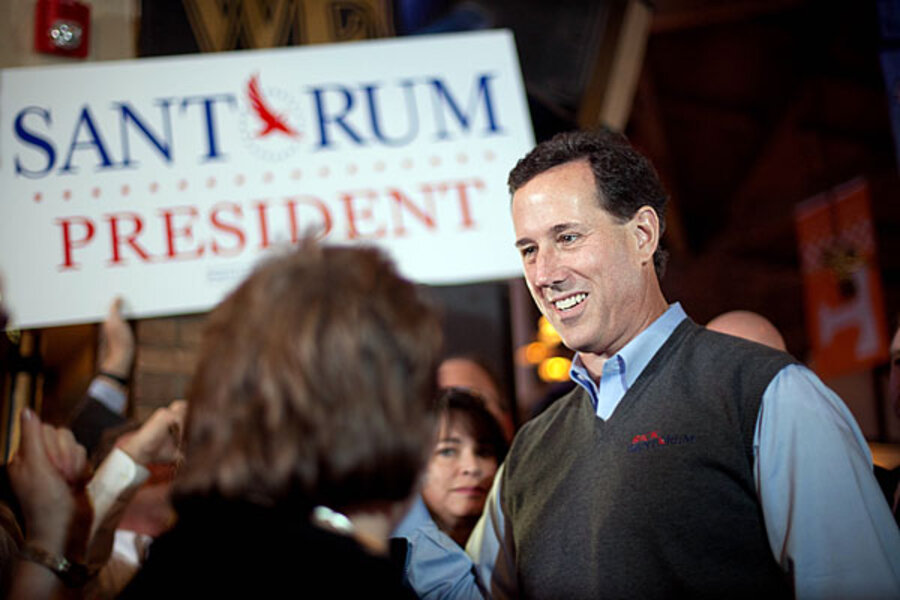Rick Santorum sweater vest: 'What not to wear' or sleeveless genius?
Loading...
It’s not often that a political candidate’s fashion choices take on a life of their own – they are after all, supposed to be plugging more, well, substantial stuff. But, the weekend before the New Hampshire primary Tuesday, the sleeveless sweater vest that former Pennsylvania Sen. Rick Santorum put on the map has become a hot Internet and retail item, with sellers from Amazon to Joseph Banks experiencing a rush in customer demand.
The mania picked up after a video called “Sleeves Slow Me Down” went viral over the weekend. That came after the vest acquired a Twitter feed of its own, @FearRicksVest, and a Tumblr under the same name. The obsession with the sartorial choices of the second-place winner in the Iowa caucus is not surprising, say political analysts and fashion watchers.
“We talk about fashion when we’ve run out of actual substantial topics to cover,” points out Republican strategist David Johnson, who worked on Sen. Robert Dole’s 1988 presidential campaign. “We’re in a 24-hour news cycle now and just about every topic in the political realm has been exhausted,” he adds.
“We’ve had 12 debates,” says Barbara O’Connor, director emeritus of the Institute for Study of Politics and Media at California State University, Sacramento. “What on earth is there possibly left to talk about that we don’t already know about these candidates?”
But Ms. O'Connor is quick to point out that as our political culture is increasingly dominated by visual communication, “especially in a campaign that has received so much coverage so far, the nonverbal take away rises to 80 to 90 percent of the communication.”
“Whether it’s Santorum’s sweater vest, Palin’s glasses, or Hillary Clinton’s pant suit, political fashion can serve to tell us something about the candidate,” says Catherine Wilson, assistant professor of political science at Villanova University.
When political fashion works well, such as Hillary Clinton’s pant suits, it serves as a candidate’s professional trademark. When it malfunctions – such as the "Mission Accomplished" incident when President Bush dressed in a flight suit on the deck of the USS Abraham Lincoln and declared an end to major military operations in Iraq – it dramatizes an already controversial event. In these cases candidates can't avoid being drawn into the world of fashion.
Political campaigns are awash in examples of the good, the bad, and the downright disastrous when it comes to fashion forays, says Thad Kousser, associate professor of political science at the University of California in San Diego. Iconic images such as 1988 Democratic candidate Paul Simon’s well-known bowtie can sum up the public’s understanding of the former senator from Illinois, he says. “He was a bit of a weenie intellectual and that bowtie said it all.” Supporters seemed to like the tie, handing out bowtie pins at events.
And when sartorial choices are disastrous they can take on a negative life of their own. “When Michael Dukakis put on that helmet and rode around in that tank,” he says, “it pretty much sealed the end of his campaign.” The image of massive military headgear completely overwhelming the man reinforced concern among some voters that he was not experienced enough to be commander-in-chief.
Mr. Santorum's sweater vest is just one of many efforts at connecting with the common man, points out Kousser. In the 1996 presidential campaign, Lamar Alexander was famous for his plaid shirts, denoting his appreciation for the everyman. Senator Scott Brown ran his senatorial campaign in Massachusetts to fill Ted Kennedy’s empty seat, sporting a barn jacket and driving a red pickup with a hitch. Even Mitt Romney, one of the wealthiest men ever to run for president, has begun sporting jeans and a no-tie look to send an all-important populist message.
Despite some progress, most political strategists say there is still very much a double standard for men and women when it comes to fashion choices. Michele Bachmann’s handlers would not allow their candidate to be photographed wearing cargo pants – even after her triumphant Iowa straw poll win. And Sarah Palin was widely criticized when word leaked out about sizable clothing expenditures at Neiman Marcus. “This is just part of that old saw that glamorous women will spend too much money and can’t be trusted,” points out Kousser.





